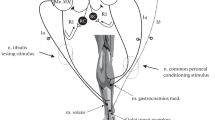Summary
Strychnine blocks inhibitory synapses and enhances spinal polysnyaptic reflexes [5, 6, 8, 9, 10]. An identical effect was produced in an animal with an inflamed area in one hindleg by intravenous strychnine; there was, however, the important difference that on the affected side the amplitude of the polysynaptic reflexes was 100–200% greater than on the other.
Also, there was a more pronounced facilitation in primary responses in the VPL of the thalamus and in the somato-sensory cortical area on the side opposite to the damaged limb (Figs. 2, 3).
Apparently, the degree of involvement of the spinal neurones, of the subcortical nuclei and of the cortex in reactions to impulses from the inflammatory focus depends upon the activity of the inhibitory synapses. When they are blocked with strychine a far greater number of neurones may become involved in the pathological reaction. Consequently the reaction may be so intense as to lose its adaptational significance.
Similar content being viewed by others
Literature Cited
Z. G. Biyasheva, Byull. éksper. biol., No. 3 (1964), p. 45.
L. N. Smolin, Transactions of the Institute of Normal and Pathological Physiology AMN SSSR, Moscow, 7 (1964), p. 86.
S. I. Frankshtein, Reflexes from pathologically altered organs, [in Russian], Moscow (1951).
P. Anderson, J. C. Eccles, I. Loyning et al., Nature, 200 (1963), p. 843.
K. Bradley, D. M. Easton, and J. C. Eccles, J. Physiol. (London), 122 (1953), p. 474.
J. S. Coombs, J. C. Eccles, and P. Fatt, Ibid, 130 (1955), p. 374.
J. M. Crawford, D. R. Curtis, and P. E. Voorhoeve, et al., Nature, 200 (1963), p. 845.
D. R. Curtis, J. Physiol. (London), 145 (1959), p. 175.
J. Eccles, The Physiology of nerve cells, [Russian translation], Moscow (1959).
J. C. Eccles, Ergebn. Physiol., 51 (1961), p. 299.
Additional information
Laboratory of the Experimental Pathology of the Nervous System (Head, Professor S. I. Frankshtein), Institute of Normal and Pathological Physiology (Director, Active Member AMN SSSR Professor V. V. Parin) Translated from Byulleten' Éksperimental'noi Biologii i Meditsiny, Vol. 59, No. 5, pp. 27–31, May, 1965
Rights and permissions
About this article
Cite this article
Frankshtein, S.I., Biyasheva, Z.G. & Smolin, L.N. Significance of the inhibitory synapses in the mechanism of compensation for impaired function. Bull Exp Biol Med 59, 497–500 (1965). https://doi.org/10.1007/BF00783068
Received:
Issue Date:
DOI: https://doi.org/10.1007/BF00783068




